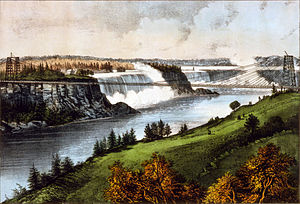Falls View Suspension Bridge
Coordinates: 43 ° 5 ′ 19 ″ N , 79 ° 4 ′ 11 ″ W.
| Falls View Suspension Bridge | ||
|---|---|---|
| use | Road bridge | |
| Crossing of | Niagara River | |
| place |
Niagara Falls, New York Clifton, Ontario |
|
| construction | Suspension bridge | |
| width | 3 m, later 5 m | |
| Longest span | 386 m | |
| start of building | 1867 | |
| opening | January 2, 1869 | |
| planner | Samuel Keefer | |
| closure | Destroyed by storm on January 9, 1889 | |
| location | ||
|
|
||
The Falls View Suspension Bridge , also known as the Upper Suspension Bridge or Niagara Clifton Bridge , was a road bridge between Canada and the United States . The suspension bridge led over the Niagara Gorge north of Niagara Falls and about 170 meters south of today's Rainbow Bridge . It connected the American city of Niagara Falls in the state of New York and the Canadian town of Clifton , which became part of the newly founded Canadian city of Niagara Falls in the province of Ontario from 1903 .
Its name Upper Suspension Bridge differentiated it from the Niagara Falls Suspension Bridge, which was built twelve years earlier and located around 2.6 km downstream .
First Falls View Suspension Bridge
The first Falls View Suspension Bridge was built by the American Niagara Falls Suspension Bridge Company and the Canadian Clifton Suspension Bridge Company according to the plans of the Canadian engineer Samuel Keefer. In the winter of 1867-68 the first rope was pulled over the frozen river, with the help of which the further work could be carried out after the frost period. The bridge was completed on December 29, 1868 and inaugurated on January 2, 1869.
The suspension bridge had a span of 386 m (1268 ft). Their bridge deck made of wooden planks was originally only 3 m wide, so that carts could only cross the river in one direction. The carrying ropes were carried by 30 m high pylons , each of which consisted of two wooden scaffolding pillars that were connected several times by horizontal and diagonal crossbars. Additional stay cables were stretched from the pylons to the deck to prevent vibrations, and there were guy lines from the deck to the rocky bank.
In 1872 the pylons were covered and provided with entrance portals. On the Canadian side, a steam-powered was Otis - lift installed to a viewing platform. In 1884 the pylons were replaced by open iron girders, and the wooden parts of the deck girder were replaced with iron girders. The financially unsuccessful elevator was not reinstalled. Between 1887 and 1888 the bridge was completely overhauled, and the deck girder was widened to 5 m.
On the night of January 9, 1889, a violent storm caused the bridge to vibrate so strongly that one of the stay cables broke. As the storm got stronger, so did the vibrations. After a few hours the bridge broke and fell into the Niagara River.
Second Falls View Suspension Bridge
Immediately after the collapse of the first Falls View Suspension Bridge, the owners commissioned the rebuilding. The rolling mills were able to deliver the required parts within 70 days based on the documents still available for the old bridge and in day and night shifts. The new building was erected in the short time from March 22nd to May 7th, 1889, so that it was opened to traffic only 117 days after the collapse of the first bridge.
The bridge was damaged in another storm in January of the next year, but ultimately survived it intact.
In the following ten years power grids were built and the first electric railways were introduced, which required bridges with significantly higher load-bearing capacity. Another company therefore built the Upper Steel Arch Bridge (Honeymoon Bridge) in the immediate vicinity , which was opened in 1898. Thereupon the second Falls View Suspension Bridge was dismantled, its parts were used for the construction of the second Lewiston – Queenston Suspension Bridge about 8 kilometers downstream.
Web links
- The First Falls View Suspension Bridge on Bridges Over Niagara Falls
- The Falls View Suspension Bridge Disaster on Bridges Over Niagara Falls
- The Second Falls View Suspension Bridge on Bridges Over Niagara Falls
- Niagara-Clifton Bridge. In: Structurae
Individual evidence
- ^ Bridges Over Niagara Falls
- ↑ Spans of 384.3 m (1261 ft) or 384 m (1260 ft) are given by Structurae and by Leonardo Fernández Troyano: Bridge Engineering. A global perspective. Colegio de Ingenieros de Caminos, Canales y Puentes, Thomas Telford 2003, ISBN 0-7277-3215-3 , p. 570

